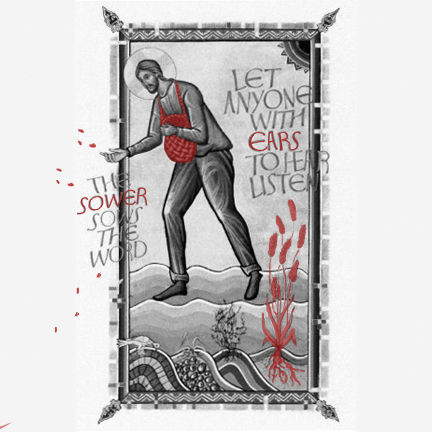
|
|
|
|
|
Class Prep
|
|
|
|
The Stories of Jesus in Luke
 Today we turn to the third "synoptic" gospel, the Gospel of Luke, to see how he changes his source Mark and what his concerns are. As you read Carter's chapter on the tale Luke tells about Jesus, be able to discuss: Today we turn to the third "synoptic" gospel, the Gospel of Luke, to see how he changes his source Mark and what his concerns are. As you read Carter's chapter on the tale Luke tells about Jesus, be able to discuss:-
- the significance of the unique way he begins his gospel, and
- how his account of Jesus' birth in chapters 1–2 differs from Matthew's.
-
- "Parables," Amy-Jill Levine tells us, "are often seen as the hallmark of Jesus' teaching" (Short Stories by Jesus, 1). We find them in the Gospel of Mark (the parable of the sower, to the right, is in Mark), in Q (the list of Jesus' sayings that predates Mark), and in the unique material in Matthew and Luke. They are riddle-like stories, using a familiar metaphor from daily life to point to another reality that is less familiar and often difficult for the readers to see or accept. They seem to be one of the main ways that Jesus "texted God."
-
- Luke's gospel has some of the most famous parables, and we will be reading two of his most famous ones this week—the prodigal son today and the good Samaritan on Wednesday. A.-J. Levine, an Orthodox Jewish scholar of the New Testament, will be our guide as she helps us to see how Jesus' parables would have sounded to his original Jewish audience, and how Christians interpreters, beginning with the gospel authors themselves, often altered that meaning as they reconstructed the memory of Jesus' teaching.
-
- For today, we'll be reading three parables in Luke 15 with a similar message that are all grouped together in Luke's gospel. Here are two more class prep questions/tasks:
-
- Use this handout to analyze the formal elements of the three parables in Luke 15, and to study the different narrative contexts into which Matthew, Thomas and Luke place the shepherd parable. Please print this handout and bring it to class.
- According to Levine, what is the "hook" of the parable of the lost son that Jesus' Jewish audience would have heard, and how does it differ from the meaning Luke makes of it?
-
 |
Today we will also begin to talk about a rather incredible textual resource right here on our campus—a facsimile copy of The Saint John's Bible. The illustration of the parable of the sower above comes from this handwritten manuscript, commissioned by the Benedictine Monks of Saint John's Abbey in Collegeville, Minnesota in 1998. Donald Jackson, calligrapher to the Queen of England, was tasked with overseeing the years'-long process as a team of calligraphers and artists produced this 7-volume text. There is only one original, but the facsimile copy we have is a work of art in itself, reproducing the volumes' size and qualities, with original gold leaf. |
 |
-
- On Friday, we will have a guided tour of this sacred text led by the Research & Instruction Services Coordinator at the University Archives, Kelci Baughman McDowell.
-
-
- Assigned Readings
-
- Primary: Luke 1–4; 15 (Action Bible 600-604; read the NRSV version of Luke 15 closely)
-
- Secondary: Carter, Telling Tales about Jesus 151-67; Amy-Jill Levine, “Lost Sheep, Lost Coin, Lost Son,” in Short Stories by Jesus; The Enigmatic Parables of a Controversial Rabbi (New York: HarperOne, 2015) 25-70 (Camino); online class prep
-
- Slides for Lecture
-
-
- Today's Authors
-
| |
 |
Warren Carter is Professor of New Testament at Brite Divinity School, part of Texas Christian University. He specializes in the Roman imperial context of early Christianity, and has written over twenty books and dozens of articles on the gospels and their political context.
is |
| |
 |
Amy-Jill Levine is the University Professor of New Testament and Jewish Studies, the E. Rhodes and Leona B. Carpenter Profesor of New Testament Studies, and Professor of Jewish Studies at Vanderilt University Divinity School in Tenessee. She is a specialist in the Christian Gospel of Matthew and in feminist studies, and is an Orthodox Jew. |
| |
 |
Sergio Cariello is a Brazilian-American comic book artist. He's published with major comic book publishers such as Marvel Comics and DC Comics, and recently has been penciling and inking "The Lone Ranger" for Dynamite Entertainment" and the "Son of Samson" series for Christian publisher Zondervan. |
-
-
- Further Reading
-
- Bailey, Kenneth E. Jesus through Middle Eastern Eyes: Cultural Studies in the Gospels. Downers Grove, Illinois: InterVarsity Press, 2008. [See especially part 6, starting on p. 279]
-
- Crossan, John Dominic. The Power of Parable: How Fiction by Jesus became Fiction about Jesus. San Francisco, HarperOne, 2013.
-
- Donahue, John R. The Gospel in Parable. Minneapolis: Fortress, 1988.
-
- Herzog, William R. II. Parables as Subversive Speech: Jesus as Pedagogue of the Oppressed. Louisville: Westminster John Knox , 1994.
-
- Jeremias, Joachim. The Parables of Jesus, trans. S. H. Hooke. New York: Scribner, 1972.
-
- Longenecker, Richard N. The Challenge of Jesus' Parables, McMaster New Testament Series. Grand Rapids, Michigan: Wm. B. Eerdmans, 2000.
-
- Schottroff, Luise. The Parables of Jesus, trans. Linda M. Maloney. Minneapolis: Fortress, 2006.
-
-
-
- Links
-
- Jesus' Parables - a list compiled for this class.
- The Saint John's Bible - The official web site of the only Bible to be handwritten since the invention of the printing press in the 15th century.
-
-
- Acknowledgements
-
|
|
|
|
|
